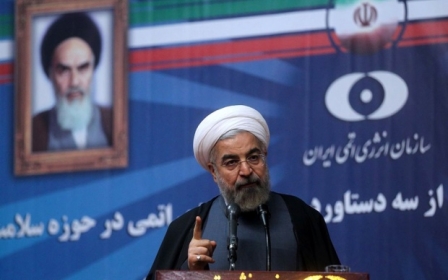Iranian fighter jets bomb IS in Iraq: US

Iranian fighter jets struck Islamic State (IS) group in eastern Iraq in recent days, the Pentagon said Tuesday, signaling Tehran's determination to confront the militants and Washington's tacit partnership with arch-foe Iran.
The air raids marked an escalation in Iran's role in a conflict that has seen Tehran and the Washington set aside their customary hostility to battle a common enemy in the IS group, which both governments view as a dangerous threat.
"We have indications that they did indeed fly air strikes with F-4 Phantoms in the past several days," Pentagon spokesman Rear Admiral John Kirby told AFP.
His comments came days after Al-Jazeera ran footage of what appeared to be an F-4 fighter, similar to those used by the Iranian air force, attacking targets in the eastern province of Diyala.
Iranian forces have been active on the ground in Iraq assisting Shiite militia and Baghdad government units, but this was the first time the United States had confirmed the Iranian air force was conducting strikes against the IS group.
No military coordination with Iran
Kirby said the United States was not coordinating with Iranian forces and that it was up to the Iraqi government to oversee military flights by different countries.
"We are flying missions over Iraq. We coordinate with the Iraqi government as we conduct those. It's up to the Iraqi government to deconflict that air space," Kirby told reporters.
"Nothing has changed about our policy of not coordinating military activity with the Iranians."
Even if there is no direct communication between the two countries' forces, the Americans likely would be aware and easily monitor flights over Iraq by Iran's less sophisticated air fleet, which uses a fighter jet that dates back to the Vietnam War.
A US air command centre in Qatar coordinates American fighters, bombers, drones and surveillance aircraft flying round-the-clock missions over Iraq along with other coalition warplanes from European governments as well as Australia and Canada.
The onslaught of the IS in Iraq has forged an unlikely alignment between Iran and the United States, which have been locked in a cold war for more than three decades.
The fight against the IS has come amid a US diplomatic drive to agree a deal with Iran over its nuclear program, and officials acknowledge the two sides have discussed the war in Iraq on the margins of the nuclear talks.
Tactical communication
Analysts and former US officials say neither country appears ready to pursue elaborate cooperation for military operations in Iraq, but there appears to be some level of tactical communication at least to avoid accidents.
Iran has close ties to the government in Baghdad, and Tehran quickly came to the government's aid after militants overran Iraqi army units in western and northern Iraq earlier this year.
Iran also has provided Sukhoi Su-25 aircraft to Iraq amid widespread speculation that the planes are flown by Iranian pilots.
Iranian weapons have made their way to Shiite fighters in Iraq, including 12.7 mm rifles designed to penetrate armored vehicles and multiple rocket launchers, according to a report by IHS Jane's Defence.
The commander of Iran's elite Quds Force, Major General Qassem Suleimani, led a counter-attack in Iraq over the summer that pushed back IS militants from a key route leading from Samarra to Baghdad, according to Lebanon's Shiite movement Hezbollah.
Suleimani flew to Baghdad on June 10, hours after the IS group seized the Iraqi city of Mosul, and hammered out a strategy "to secure Baghdad and its surroundings," according to the Shiite group's Al-Manar website.
Suleimani also reportedly has had a hand in operations against the IS group in Amerli in the north and in eastern Iraq near the Iranian border. Iranian television last month released a rare photo of Suleimani in Iraq with Kurdish peshmerga fighters, promoting Tehran's role in the fight against IS.
Iran has declined to join the US-led coalition against the IS group and publicly dismissed the air war, but Tehran's Iraqi allies have benefited from the strikes against IS.
Middle East Eye propose une couverture et une analyse indépendantes et incomparables du Moyen-Orient, de l’Afrique du Nord et d’autres régions du monde. Pour en savoir plus sur la reprise de ce contenu et les frais qui s’appliquent, veuillez remplir ce formulaire [en anglais]. Pour en savoir plus sur MEE, cliquez ici [en anglais].




